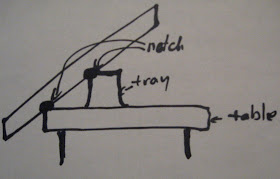The cardboard for these packing corners is so sturdy that this apparatus has lasted eight years. I have duct taped the entire length of the chute because tearing the duct tape off each time I took the apparatus down ripped off some of the top layer of cardboard of the chute. It also makes a more slippery surface for material to slide down.
If you look at the right column at the DIMENSIONS to think about when building apparatus for the sensory table, you will note that this apparatus is an incline and that it is open. Under the AXIOMS for the sensorimotor play, you will note that apparatus adheres to the axiom that children are naturally drawn to pouring, rolling and sliding materials and objects down ramps, chutes and tubes.
After using the apparatus for a couple of years, I felt the need to attach it more securely to the tray and the table. I made notches with a utility knife in the bottom of the chutes to line up with the tray and the table. See the crude diagram below.
Here is what it looks like in the room. This picture also gives you an idea of the amount of tape and crossing patterns of the tape that hold it tight to the table and the tray. Since it is not store-bought, it is not pretty. It is, however, quite attractive to children and facilitates many kinds of play and experimentation.
That play and experimentation takes place at the top.
At the middle.

At the bottom.
And every place in between.





No comments:
Post a Comment